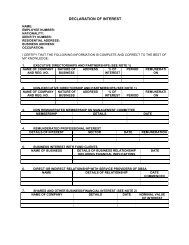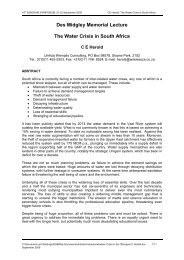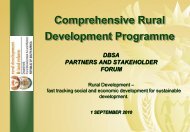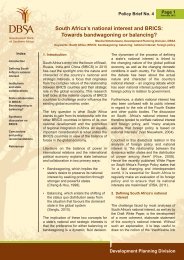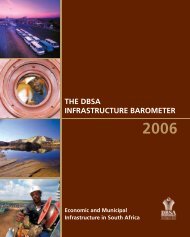ANNUAL REPORTS
ANNUAL REPORTS
ANNUAL REPORTS
You also want an ePaper? Increase the reach of your titles
YUMPU automatically turns print PDFs into web optimized ePapers that Google loves.
Macroeconomic overview<br />
Rehabilitating Spekboom in the Eastern Cape.<br />
In the past year, the global economy began to recover<br />
but conditions remained challenging around the world.<br />
The sources of the challenge varied from country to<br />
country. In some, it was the economic and financial<br />
aftermath of the global crisis and the ensuing recession.<br />
Others were affected by long-running structural macroeconomic<br />
problems and resulting imbalances. Still others<br />
faced the legacy of uneven socio-economic development,<br />
poverty and inequality on both a country and a global level.<br />
For the DBSA, 2010/11 was equally challenging. South<br />
Africa and the SADC region experienced both favourable<br />
and adverse economic conditions, as they continued to<br />
confront formidable challenges in the economic, financial<br />
and institutional realms.<br />
Global conditions<br />
After the sharp contraction in what has been called the<br />
“Great Recession” of 2009, the global economy stabilised<br />
in the latter part of 2009 and then rebounded surprisingly<br />
strongly in the early part of 2010. Although the recovery<br />
continued, it ebbed somewhat during the year, as various<br />
limiting factors came into play.<br />
Driven by internal forces, the rapidly industrialising and<br />
urbanising developing countries of Asia – China and<br />
India in particular – had weathered the global recession<br />
particularly well and were pulling the global economy out<br />
of recession. However, many of the advanced economies<br />
of North America and Europe were mired in structural<br />
problems, with economic recovery at best tentative and,<br />
at worst, still some way off. The deep economic problems<br />
that affected their recovery included high fiscal deficits, high<br />
levels of personal debt, poor international competitiveness,<br />
high levels of unemployment, and public austerity measures<br />
implemented in an effort to rectify an untenable fiscal situation.<br />
Superimposed on this pattern, two factors in particular<br />
slowed the pace of the global recovery. The first was signs<br />
of overheating in the fast-growing Asian economies and in<br />
22 DBSA DBSA | <strong>ANNUAL</strong> | <strong>ANNUAL</strong> REPORT REPORT 2010/11 2010/11



